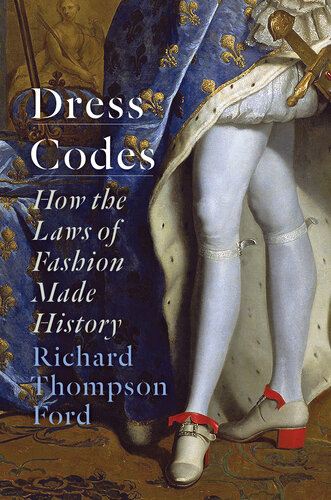
Dress Codes
How the Laws of Fashion Made History
فرمت کتاب
ebook
تاریخ انتشار
2021
نویسنده
Richard Thompson Fordناشر
Simon & Schusterشابک
9781501180095
کتاب های مرتبط
- اطلاعات
- نقد و بررسی
- دیدگاه کاربران
نقد و بررسی

November 23, 2020
Ford (Rights Gone Wrong), a Stanford University law professor, delivers an intriguing history of formal and informal rules governing what people wear. He details laws against “sumptuous clothing” in medieval and Renaissance Europe, and reveals that the Catholic church established dress codes partly to “stabilize the relationship between attire, sex, and religious faith.” (In 1434, Ford notes, the Bishop of Ferrara in Northern Italy decreed that only prostitutes could wear dresses with trains.) Ford’s wide-ranging survey also discusses the toga in ancient Rome, “monstrously extravagant” trunk hose worn by men in Elizabethan England, powdered wigs in colonial America, and zoot suit–clad Latinos who were attacked by white mobs in East L.A. during WWII. Photographs and drawings illuminate both the titillating (a nun’s habit as fetish wear in Victorian England) and the mundane (the modern-day “Midtown Uniform” of an Oxford shirt, khaki pants, and Patagonia fleece vest). Among the plethora of sartorial arcana, Ford notes that in some 15th-century Italian cities, Christian women were forbidden from wearing earrings, while it was illegal for Jewish women not to wear them (and thereby “ to exhibit a visible sign of her community”). Though Ford’s sprawling overview drags in some sections, he makes a convincing case that dress codes reveal much about the social order and the pursuit of individual liberty. This jam-packed history casts its subject in a new light.

January 1, 2021
Clothes make the person--and a social code that defies resistance. Stanford law professor Ford opens with a memory of his "rigorous and refined" father, a minister and scholar who "endured my sartorial misadventures (asymmetrical 'new-wave' haircuts, nylon parachute pants, the 'punk' look, which consisted of deliberately torn garments held together with safety pins or duct tape) in quiet despair." Of course, that garb was part of the costume by which one identifies with a group, and it speaks to a point Ford frequently reiterates: We all abide by dress codes, whether required to do so or not. The author's discussion embraces a vast body of knowledge, from what might be called fashion anthropology to a philosophy of sartorial splendor, and he's an assured, genial narrator. He has an acute eye for detail, too. We eagerly follow his gaze from the well-dressed young men and women who sat in at lunch counters during the civil rights era to the Black Panthers' "quasi-military style that combined berets, aviator sunglasses, bohemian turtleneck sweaters, and long, sleek leather jackets." Ford's referents extend deep into the past. He notes that one reason that Joan of Arc was tried and burned for heresy was her penchant for wearing male clothing, in violation of biblical precept. As a lawyer, Ford is naturally drawn to disputation, and there's plenty to cover. Lawsuits concerning makeup, cornrows, hairnets, miniskirts, and bare midriffs punctuate his pages while bodies of regulations such as Louis XIV's order that "only members of his royal court would be allowed to wear shoes with red heels" turn up frequently. Particularly relevant are Ford's observations on how formal dress codes tend to target the least powerful--women, minorities, the poor--and can serve, as he points out, "to undermine self-esteem." The author also includes a "timeline of important dress codes and historical events." For the clotheshorse and the jeans-clad alike, a lucid, entertaining exploration of how and why we dress as we do.
COPYRIGHT(2021) Kirkus Reviews, ALL RIGHTS RESERVED.

January 1, 2021
This is an overview of dress codes and how they communicate messages about cultural, political, religious, class, and tribal affiliations. Stanford law professor Ford (Rights Gone Wrong, 2011), once a runner-up in Esquire's ""Best Dressed Real Man"" contest, explores the symbolism of attire, beginning ostensibly in the middle ages and tackling just about every aspect of personal adornment from body piercing to cultural appropriation, from togas to grillz. This is not a straightforward, chronological history of fashion. Instead, Ford considers broad themes in chapters with titles like ""From Rags to Resistance,"" ""Piercing the Veil,"" and ""Recoding Gender,"" citing examples from various cultures and time periods. He reflects on how fashion choices (including nudity) can reaffirm identity, assert individuality, and camouflage nature or intent. His engaging text provides ample historical and social context, and is sprinkled with period quotes, cartoons, photos, and advertisements. Whether addressing codpieces, Ruth Bader Ginsberg's lace collars, dreadlocks in the workplace, or pandemic curbside cocktail party attire, Ford's writing is fresh, informative, and thoroughly enjoyable.
COPYRIGHT(2021) Booklist, ALL RIGHTS RESERVED.

























دیدگاه کاربران